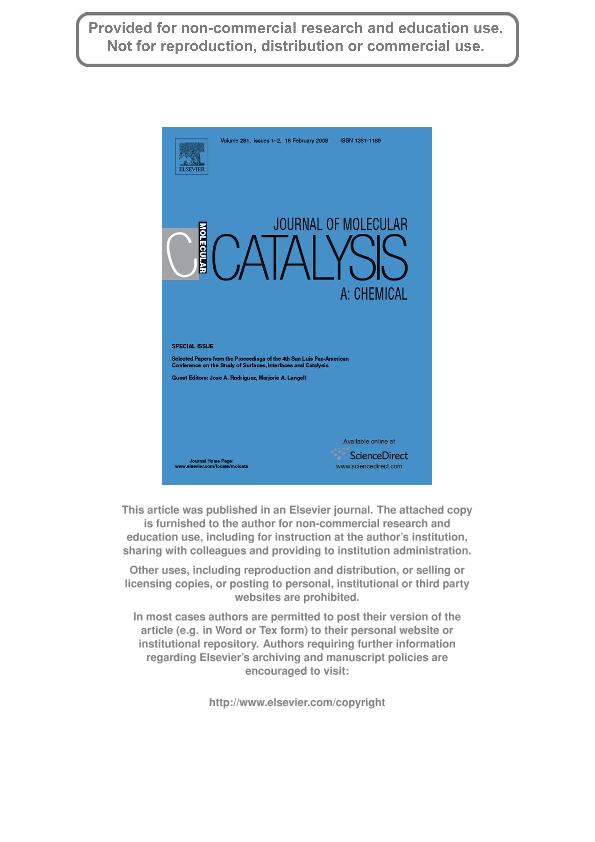Mostrar el registro sencillo del ítem
dc.contributor.author
Pereira, Amalia Luz C.
dc.contributor.author
Berrocal, Guillermo Jose P.
dc.contributor.author
Marchetti, Sergio Gustavo

dc.contributor.author
Albornoz, Alberto
dc.contributor.author
de Souza, Alexilda O.
dc.contributor.author
Rangel, Maria do Carmo

dc.date.available
2018-01-05T18:53:47Z
dc.date.issued
2007-07-28
dc.identifier.citation
Albornoz, Alberto; Marchetti, Sergio Gustavo; Rangel, Maria do Carmo; de Souza, Alexilda O.; Berrocal, Guillermo Jose P.; Pereira, Amalia Luz C.; et al.; A comparison between the precipitation and impregnation methods for water-gas shift catalysts; Elsevier Science; Journal of Molecular Catalysis A: Chemical; 281; 1-2; 28-7-2007; 66-72
dc.identifier.issn
1381-1169
dc.identifier.uri
http://hdl.handle.net/11336/32424
dc.description.abstract
The precipitation and impregnation methods in the preparation of chromium-doped magnetite for water gas shift reaction (WGSR) were compared in this work. This reaction is an important step in the commercial production of highly pure hydrogen from natural gas or naphtha feedstocks. It was found that the preparation method affects both the textural and catalytic properties of chromium-doped magnetite. However, chromium was able to preserve the specific surface area during the WGSR and to delay the metallic iron production, independently of the preparation method. Chromium caused a decrease in activity per area, depending on the preparation method. This fact was assigned to its ability in making the production of Fe2+ species more difficult, making the catalytic sites less active, because the redox cycle of the reaction becomes more difficult. The most active catalyst was obtained by adding chromium by impregnation, which led to a large amount of total chromium in the solid and then a catalyst with high specific surface area was produced. It was showed that the catalysts can be prepared in the active phase avoiding the reduction step, before reaction
dc.format
application/pdf
dc.language.iso
eng
dc.publisher
Elsevier Science

dc.rights
info:eu-repo/semantics/openAccess
dc.rights.uri
https://creativecommons.org/licenses/by-nc-sa/2.5/ar/
dc.subject
Chromium-Doped Magnetite
dc.subject
Hydrogen
dc.subject
Wgsr
dc.subject.classification
Otras Ingeniería Química

dc.subject.classification
Ingeniería Química

dc.subject.classification
INGENIERÍAS Y TECNOLOGÍAS

dc.title
A comparison between the precipitation and impregnation methods for water-gas shift catalysts
dc.type
info:eu-repo/semantics/article
dc.type
info:ar-repo/semantics/artículo
dc.type
info:eu-repo/semantics/publishedVersion
dc.date.updated
2017-07-10T13:23:21Z
dc.journal.volume
281
dc.journal.number
1-2
dc.journal.pagination
66-72
dc.journal.pais
Países Bajos

dc.journal.ciudad
Amsterdam
dc.description.fil
Fil: Pereira, Amalia Luz C.. Universidade Federal da Bahia. Instituto de Quımica; Brasil
dc.description.fil
Fil: Berrocal, Guillermo Jose P.. Universidade Federal da Bahia. Instituto de Quımica; Brasil
dc.description.fil
Fil: Marchetti, Sergio Gustavo. Consejo Nacional de Investigaciones Científicas y Técnicas. Centro Científico Tecnológico Conicet - La Plata. Centro de Investigación y Desarrollo en Ciencias Aplicadas ; Argentina
dc.description.fil
Fil: Albornoz, Alberto. Instituto Venezolano de Investigaciones Cientıficas. Centro de Quımica; Venezuela
dc.description.fil
Fil: de Souza, Alexilda O.. Universidade Estadual do Sudoeste da Bahia; Brasil
dc.description.fil
Fil: Rangel, Maria do Carmo. Universidade Federal da Bahia. Instituto de Quımica; Brasil
dc.journal.title
Journal of Molecular Catalysis A: Chemical

dc.relation.alternativeid
info:eu-repo/semantics/altIdentifier/doi/http://dx.doi.org/10.1016/j.molcata.2007.07.042
dc.relation.alternativeid
info:eu-repo/semantics/altIdentifier/url/http://www.sciencedirect.com/science/article/pii/S1381116907004645
Archivos asociados
